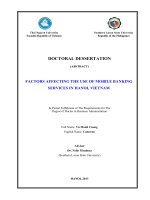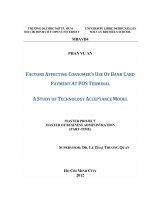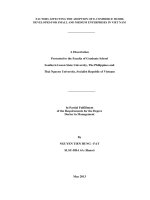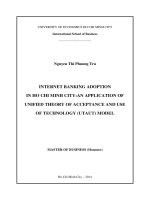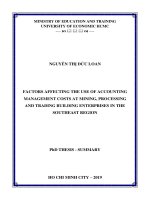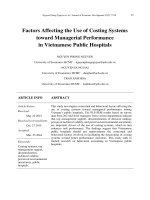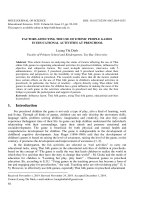Factors affecting consumers use of bank card payment at POS terminal A study of technology acceptance model
Bạn đang xem bản rút gọn của tài liệu. Xem và tải ngay bản đầy đủ của tài liệu tại đây (1.31 MB, 108 trang )
TRNG I HC M TP. HCM UNIVERSITÉ LIBRE DE BRUXELLES
HO CHI MINH CITY OPEN UNIVERSITY SOLVAY BRUSSELS SCHOOL
MBAVB4
PHAN VU AN
FACTORSAFFECTINGCONSUMER’SUSEOFBANKCARD
PAYMENTATPOSTERMINAL
ASTUDYOFTECHNOLOGYACCEPTANCEMODEL
MASTER PROJECT
MASTER OF BUSINESS ADMINISTRATION
(PART-TIME)
S
UPERVISOR: DR. LE THAI THUONG QUAN
HO CHI MINH CITY
2012
Page | i
STATEMENTOFORIGINALAUTHORSHIP
I certify that the substance of the research thesis has not been submitted for any degree
and is not currently being submitted to any other degree or qualification.
I also certify that, to the best of my knowledge, any help received in preparing this thesis,
all sources used have been acknowledged in this thesis.
________________________________
Phan Vu An
January 26
th
, 2012
Page | ii
ACKNOWLEDGMENTS
“Stay hungry, stay foolish” – Steve Jobs
I don’t know much about Steve Jobs but I am inspired by his philosophy to build up
Apple and stories about him which become a legend. To start and complete a mission, it is
necessary to be hungry and foolish from the first second. That has been my motto since I
started this final project.
I owe a debt of gratitude to many people who helped me complete this thesis. I would like
to acknowledge the help of all. First and foremost, I would like to thank my family who give
me a great encouragement and support to complete not only 2-year journey of this MBA
program but also all struggles I have met in study as well as work.
I would like to express my warmest thanks to my supervisor, Dr. Le Thai Thuong Quan,
for all challenges, enthusiastic encouragement and precious comments. Although I am the only
author reported on the cover of this thesis, and I take full responsibility for the views
expressed here or any remaining errors, I would like to highlight that the fingerprint of Dr. Le
Thai Thuong Quan is well anchored in the following pages. His striving for clearness of
exposition and challenges improved my work considerably.
I would like to express my thanks for my sponsors, Mr. Le Tri Thong and Mr. Tran Duy
Khiem at Dong A Bank, for your great sponsorships from the beginning to the end. Banking
and financial card are quite new and challenge for technical guys. At the first steps to find out
project’s idea, your supports helped me to understand from first cut to deep dive in specific
problems. I would believe this report is worthy of your great supports.
I would like to express my thanks for my friends, especially Ms. Nguyen Thi Kim Thoa
and Ms. Vu Phuong Nghi, who helped me to review this report many times, corrected my
English and gave valuable comments. Every time I talk with you, I always explored something
new which helped me to improve towards betterment. To other friends who gave me a hand in
data collection as well as discussion and opinions, please know that your comments are of
great value to the completion of my project.
Last but not least, I would like to express my thanks to Solvay program, all professors, all
coordinators and all friends at MBAVB4 who have accompanied me in this journey. I would
take this chance to wish you all the best in your future endeavors
HCMC, January 26
th
, 2012
Phan Vu An
Page | iii
SUPERVISOR’SCOMMENTS
The topic is practical and the thesis has been done carefully and thoroughly. The choice of
TAM model for this problem is suitable. In addition, the author has fulfilled an extensive
literature review to propose a framework for analysis. The sample size of the survey is
acceptable and the data analysis has been done appropriately to give meaningful results. This
thesis is ready for public defense.
________________________________
Dr. Le Thai Thuong Quan
January 30
th
, 2012
Page | iv
ABSTRACT
Purpose – This study addresses factors that affect consumer’s use of card payment at
POS terminal. In Vietnam, the growth of cards and POS terminal are impressive in recent
years. It has been recorded that there were over 32 million of card and 54,000 POS terminals
in Vietnam at the end of year 2010. However, consumers are still not so familiar with card
payment at POS terminal. This study aims to choose an appropriate model to evaluate
consumer decision in card payment, evaluate factors affected to consumer intention to use
POS for payments, and from there, contribute to the understanding on consumer and merchant
for business strategy development of bank by quantitative approach.
Design/Methodology/Approach – The study is constructed base on Technology
Acceptance Model (TAM) with additional factor which are Perceived Usefulness, Perceived
Ease-of-Use and Perceived Creditability. Electronic questionnaire was distributed via email to
consumers. The selected respondents are categorized into 2 groups, non-credit and credit
consumer. After reliability tests, in-depth analysis is conducted to understand factors affecting
consumer’s use and independent sample t-tests/ANOVA are used to examine difference of
demographic dimensions.
Key Findings – Toward consumers who have used card payment in POS terminal,
demographic dimensions are not the keys drive usage behavior. Consumers recognize
Perceived Usefulness, Perceived Ease-of-Use and Perceived Creditability affecting to their use
significantly. Top 3 recommendations are (1) banks need better care for debit card users by
product/service diversification, (2) the target consumer group are recommended, and (3)
personal finance education.
Originality/Value – Study helps to conceptualize factors affecting to consumer’s use of
card payment at POS terminal in Vietnam context. However, the respondents received
questionnaire via email. 80% of our survey population merely consisted of white collar
officers mostly in Hanoi and Ho Chi Minh City, two major cities in Vietnam. There are other
potential groups left open, such as housewife/househusband, students. These are opportunities
for further studies to explore potential loyal consumers.
Key words – Card payment, POS terminal, debit card, credit card, ATM card,
Technology Acceptant Model (TAM), Vietnam.
Page | v
TABLEOFCONTENTS
STATEMENT OF ORIGINAL AUTHORSHIP i
ACKNOWLEDGMENTS ii
SUPERVISOR’S COMMENTS iii
ABSTRACT iv
TABLE OF CONTENTS v
LIST OF FIGURES viii
LIST OF TABLES ix
LIST OF ABBREVIATIONS x
CHAPTER 1: INTRODUCTION AND RESEARCH PROBLEM 1
1. Introduction 1
1.1. Bank Card Overview 1
1.2. Development of ATM and POS terminal 2
1.2.1. ATM 2
1.2.2. POS terminal 3
1.3. Prominence of cash payment 4
2. Research Problem, Question, Objectives and Scope 5
2.1. Research Problem 5
2.2. Research Question 6
2.3. Research Objectives 7
2.4. Research Scope 7
3. Thesis Structure 8
CHAPTER 2: LITERATURE REVIEW & RESEARCH FRAMEWORK 9
1. Card Payment at POS terminal 9
2. Technology Acceptance Model (TAM) 11
3. Framework for consumer’s use of card payment at POS terminal 15
3.1. Categorization of Respondent 16
Page | vi
3.2. Perceived Usefulness 16
3.3. Perceived Ease-of-Use 19
3.4. Perceived Creditability 20
3.5. Personal characteristics of consumers 21
3.6. Research Framework 22
CHAPTER 3: RESEARCH METHODOLOGY & DESIGN 24
1. Methodology 24
1.1. Research Design 24
1.2. Research Approach 24
1.2.1. Secondary research 25
1.2.2. Primary research 26
1.3. Research Strategies 26
2. Questionnaire and Sampling 27
3. Data Analysis Procedures 30
3.1. Descriptive statistics analysis 30
3.2. Data Examining and Reliability Test of the Measurement Variables 30
3.3. Compare Means: Independent Sample T-test & One Way Analysis of Variance
(ANOVA) 31
CHAPTER 4: ANALYSIS & DISCUSSION 32
1. Descriptive Analysis 32
1.1. Demographic Characteristics of Respondents 32
1.2. Behavioral Characteristics of Respondents on Bank Card Use 36
2. Reliability Test 40
2.1. Non-Credit Respondent 41
2.1.1. Perceived Usefulness 41
2.1.2. Perceived Ease-of-Use 42
2.1.3. Perceived Creditability 43
2.2. Credit Respondent 44
Page | vii
2.2.1. Perceived Usefulness 44
2.2.2. Perceived Ease-of-Use 45
2.2.3. Perceived Creditability 46
3. Factors affecting Actual Use 49
3.1. Perceived Usefulness 49
3.2. Perceived Ease-of-Use 52
3.3. Perceived Creditability 54
4. Differences on Demographic Dimensions 55
4.1. Gender of Respondents 55
4.2. Age-Group of Respondents 56
4.3. Education Level of Respondents 57
4.4. Income of Respondents 59
5. Barriers of Card Payment at POS terminal 61
5.1. Fee charged at merchant – Perceived Cost of Consumers 61
5.2. Reason to say NO use 63
CHAPTER 5: CONCLUSION 65
1. Conclusion 65
2. Contributions and Managerial Implications 67
3. Study limitation and Recommendation for Further Study 73
REFERENCES 75
APPENDIX 1: QUESTIONNAIRE 78
APPENDIX 2: Types of Bank Card’s Function in Vietnam 85
APPENDIX 3: History and Development of POS terminal 93
Page | viii
LISTOFFIGURES
Figure 1 - Number of ATMs and POS terminals, 2005-2010 3
Figure 2 - Market Share of ATM machines and POS Terminals in Vietnam in 2010 6
Figure 3 - Thesis Structure 8
Figure 4 - The Original TAM 12
Figure 5 - First modified version of TAM 13
Figure 6 - Final version of TAM 14
Figure 7 - Research Framework 23
Figure 8 - Question Flowchart 28
Figure 9 - Data Analysis Procedures 30
Figure 10 - Gender & Age Group of Respondents 34
Figure 11 - Education Level of Respondents 35
Figure 12 - Bank & Card Used of Respondents 36
Figure 13 - Cross Tabulation of Income and Willing-to-Pay Amount 38
Figure 14 - Cross Tabulation of Income and Occupation 38
Figure 15 - Preferable Places to Use Card Payment 39
Figure 16 - Perceived Usefulness of Non-Credit Respondents 50
Figure 17 - Perceived Usefulness of Credit Respondents 51
Figure 18 - Perceived Ease-of-Use of Non-Credit and Credit Respondents 53
Figure 19 - Perceived Creditability of Non-Respondents and Credit Respondents 54
Figure 20 - Perceived Creditability by Income if Non-Credit Respondents 61
Figure 21 - Frequency Use of Card Payment at POS terminal 62
Figure 22 - Reason of NO use Card Payment at POS terminal 63
Figure 23 - Vietcombank promotes card payment at Big C supermarket 68
Figure 24 - 5-step model 71
Figure 25 - ATM Cards 85
Figure 26 - ATM Cards Category Performance (2005 - 2010) and Forecast (2010 - 2015) 86
Figure 27 - Debit Card 88
Figure 28 - Credit Card 89
Figure 29 - Prepaid Cards of Sacombank and Asia Commercial Bank 91
Figure 30 - Typical Configuration of POS terminal 93
Page | ix
LISTOFTABLES
Table 1- Financial Cards: Number of Cards in Circulation 2005-2010 2
Table 2 - Financial Cards and Payments in Vietnam in 2010 2
Table 3 - Applications, participants, country and setting used for applying TAM 15
Table 4 - Questionnaire for measuring factors 28
Table 5 - Cross Tabulation of EVER-USE-CARD-PAYMENT and INCOME 33
Table 6 - Cross Tabulation of Sector and Occupation 34
Table 7 - Reliability of Perceived Usefulness for Non-Credit Respondents 41
Table 8 - Reliability of Perceived Usefulness for Non-Credit Respondents after removal
of PU2 and PU4 42
Table 9 - Reliability of Perceived Ease-Of-Use for Non-Credit Respondents 43
Table 10 - Reliability of Perceived Creditability for Non-Credit Respondents 43
Table 11 - Reliability of Perceived Usefulness for Non-Credit Respondents after removal
of PU2 and PU4 44
Table 12 - Reliability of Perceived Ease-Of-Use for Non-Credit Respondents 45
Table 13 - Reliability of Perceived Ease-Of-Use for Non-Credit Respondents after
removal of PEU4, PEU7 46
Table 14 - Reliability of Perceived Creditability for Credit Respondents 46
Table 15 - Summary of Reliability Analysis 47
Table 16 - Results for Relevant Research Variables 47
Table 17 - T-test result of Gender of Respondent 56
Table 18 - ANOVA result of Age of Respondents 57
Table 19 - T-test result of Education Level of Respondents 58
Table 20 - ANOVA result of Income of Respondents 60
Page | x
LISTOFABBREVIATIONS
Abbreviation Description
ATM Automated Teller Machine
POS Terminal Point-Of-Sale Terminal
PIN Personal Identification Number
TAM Technology Acceptance Model
PU Perceived of Usefulness
PEU Perceived Ease-of-Use
PC Perceived Creditability
One way ANOVA One Way Analysis of Variance
Page | 1
CHAPTER1:INTRODUCTIONANDRESEARCHPROBLEM
1.Introduction
1.1.BankCardOverview
In comparison with Payment Activities through Financial Card developed from 1920s in
over the world, Payment Activities through Financial Card in Vietnam has more than 20 years
younger in development. In the beginning years, some banks, such as Vietcombank (VCB),
Asia Commercial Bank (ACB) which were pioneers in this sector were merchants of
International Card Operators, such as MasterCard®, Visa®. In 1996 – 1997, some commercial
banks of Vietnam became official members of those organizations, established the network to
provide international payment services and issue international cards. However the consumer’s
understandings on cashless payment were quite limited, so these kinds of product and services
were segmented for high income class to do international payments. From 2002, on the
foundation of core banking upgraded, banks deployed the specific applications, such as local
debit card, while Vietcombank installed ATM network, the market had a milestone change at
that time. Following that, other banks invested to develop local debit cards. People had known
about payment via bank card as convenient payment which is easy to use, easy to issue by
personal bank account. From there, there has been a significant change of payment services
and card issue, inclusion of more banks in this market and more modern card products with
more functions and features.
There were 28.6 million ATM cards accumulated issued up to 2010. Let assume there are
only 50% of consumers, which means 15 million consumers open bank account with the
average monthly balance is 2 million VND per account (Nguyn Thu Hà, 2011); local
payment activities contributed 30,000 billion VND for capital collection. It is a remarkable
number in current financial activities.
Page | 2
Up to 2010, there were 49 banks that had issued financial card, among these 18 banks
issued international debit card (such as VISA Debit) and 17 banks issued international credit
card. Nearly 50% of commercial banks in the market joined financial card market with over
200 card brands with many different features
Table 1- Financial Cards: Number of Cards in Circulation 2005-2010
'000 cards 2005 2006 2007 2008 2009 2010
ATM/Debit Function 920 5,808 8,665 14,950 21,300 28,648.5
Credit Function 265 272 285 325 349.8 384.8
Pre-Paid Function 65 120 150 230 363 464.6
Financial Cards in Circulation 1,250 6,200 9,100 15,500 22,000 29,480
Source, Euromonitor International, 2010
The year 2010 recorded a fast growth of financial card market in Vietnam. In 2011
Annual Report of Vietnam Bank Card Association, Vietnam has got a significant change in all
fields of financial card, such as card issue, payment, diversity and network development
Table 2 - Financial Cards and Payments in Vietnam in 2010
Item Unit Year 2010
Number of Financial Card in Total (accumulated) Million Card 32
Revenue of Payment via all types of Cards Million USD 29,111
Revenue of Cash Withdraw at ATM Million USD 21,474
# of ATM (accumulated) Machine 11,696
# of POS terminal (accumulated) Machine 53,952
Source, Vietnam Bank Card Association, 2011
1.2.DevelopmentofATMandPOSterminal
1.2.1.ATM
Figure 1 shows a 6-time increase of number of ATM machines from 2005 to 2010; this is
huge effort of banks to build up the infrastructure. Beside the basic features which are cash
withdraw, transfer, etc. banks are proactive to provide other added features in ATM system,
Page | 3
such as paying for service invoice (electric, water, phone, insurance, etc.), that support to bring
value to consumers, reduce the cash-payment
Figure 1 - Number of ATMs and POS terminals, 2005-2010
Source, Euromonitor International, 2010
1.2.2.POSterminal
Figure 1 shows a 4-time increase of number of POS terminal from 2005 to 2010, banks
were proactive in broadening the businesses that accept payment through POS terminal,
especially retail business, daily service supply, such as flight ticket, taxi, etc.
With the strong development of payment system infrastructure, State Bank required
about the connection of Switch Operators to synchronize the country acceptance network for
financial card. From 2008, banks in Vietnam and Switch Operators, such as Smartlink
1
,
Banknet
2
and VNBC
3
, have continued to widen their own system by connecting more banks to
system. Up to now, ATM system has nearly covered all market. Consumers can make their
transaction in ATM of other banks with a fee to Switching Operators. Follow the success of
ATM synchronization, POS has been connected in Hanoi in October 2010, Ho Chi Minh City
in December 2010, and Danang in March 2011 and deploying in over country now. This is the
1
www.smartlink.com.vn
2
www.banknetvn.com.vn
3
www.vnbc.com.vn
2005 2006 2007 2008 2009 2010
NoofATMs
1.8 3 4 6 9.7 11.7
NoofPOSterminals
11 14 17 22 36.6 53.9
0
10
20
30
40
50
60
'000Units
NumberofATMsandPOSterminals,2005 2010
Page | 4
direction of State Bank to synchronize POS system like ATM. These synchronizations have
not only supported to consumer for convenient and flexible use, but also increased the
effectiveness of bank activities and investment for system development. Besides, government
also supports for social in enabling cashless society, i.e. decision to encourage enterprise pay
salary for employees via bank accounts (Directive No. 20/2007/CT-TTg of Prime Minister
dated August 24, 2007; Directive No. 05/2007/CT-NHNN of the State Bank of Vietnam
Governor dated October 11, 2007 on salary payment via bank accounts to state budget
beneficiaries in the first 6 months of 2010 in their locations).
In parallel with development of infrastructure, revenue of this section has gained
continuously year on year. Moreover, payment system in Vietnam has accepted the
international card, such as Visa, MasterCard, American Express, JCB, Diners Club, CUP and
Discovery Card which are the top brands and popular nowadays
1.3.Prominenceofcashpayment
Cash transactions registered retail value growth of 18% in 2010 as consumers continued
to use mainly cash to make purchases despite the increasing presence of POS terminals in
many modern retail outlets. The popularity of cash transactions also remained strong because
some retailers charged an extra fee to consumers who paid by card, which thus deterred some
consumers from engaging in card transactions. In addition, staff members in many retail
outlets were not properly trained in conducting card transactions. As a result, many errors
were made when performing card transactions, which resulted in annoyance among
consumers. Furthermore, lack of promotion by banks and retailers to raise consumer
awareness of card transactions meant that consumer preference for cash remained strong.
The strong custom of using cash to make purchases and lack of promotion of cards as a
means of making purchases meant that cash was still very much the preference of Vietnamese
consumers in 2010. Many consumers, although they were accustomed to using cards when
they travelled overseas, returned to making cash payments when they were back in Vietnam.
In addition, various consumers, in particular those who seldom travelled and those who had
Page | 5
little education on the use of cards, continued to use cash as they were unaccustomed to using
cards and often unaware that cards could be used to make purchases.
The popularity of using cash to make payments is expected to remain very strong in the
short term, as many consumers are expected to continue to prefer using cash. However,
governmental initiatives to pay the salaries of employees in all state-owned companies through
bank transfers are expected to force many consumers to open bank accounts, which will
provide banks with a strong platform on which to promote card payments.
Although the custom of using cash to make payments is expected to remain in Vietnam
for quite some time, there is potential for financial cards and payments to grow over the
forecast period. The Vietnamese population includes many young consumers who are strongly
affected by western culture and who adapt quickly to cultural changes. They are expected to
be the target consumers when banks start to promote modern payment methods and to speed
up the transition from cash to cards. Also, competition among retailers will lead to better
training of staff and increased service, which is expected to make card transactions more
convenient.
In summary, the growth of new young/dynamic consumers and the diversity of
products/services that banks imitating are expected eagerly to drive consumer behavior and
promote card payment at POS terminal in modern society.
2.ResearchProblem,Question,ObjectivesandScope
2.1.ResearchProblem
The growth rate of number of ATM machine in 2010 is around 20% but it didn’t come
from the big players of ATM market. The main reason of low investment to develop ATM
network is low profit, banks have to spend capital to invest but limit revenue, State Bank has
not allowed collecting service fee for ON-US (card-holder of issuing-bank). Instead of
investment to build more ATM machines, banks have targeted to increase the service quality,
Page | 6
features added, system re-structuring for security and assurance. Besides, banks have started to
invest to POS market.
As seen in Figure 1, the growth of POS terminal is quite impressive and attractive for
anyone who wants to join the POS market, the growth rate of 2010 was at almost 50%
increase comparing to 2009. While ATM has not been the attractive, POS has become
question-mark market. In the severe competition, many banks, such as Vietinbank still gets 3
times increasing, Ocean bank gets 3.4 times increasing, have keeping growing. This says POS
is a big potential market.
Figure 2 - Market Share of ATM machines and POS Terminals in Vietnam in 2010
Source: Vietnam Bank Card Association, 2011
Cash payment was still by far the most popular method of payment in Vietnam. Many
consumers, even though they possessed credit or debit cards, still preferred to use cash to
make payments for purchases owing to the very strong custom of doing so in Vietnam.
Furthermore, the continued dominating presence of traditional retailers in 2010 meant that
consumers needed cash for every day transactions.
A strategic question has been called out: What are the opportunities for POS market?
2.2.ResearchQuestion
In POS market, there are 3 players, (1) Banks (2) Merchants, (3) Consumers. To join this
market, any players, have their own concerns to make profit.
15%
13%
13%
11%
9%
39%
MarketShareofATMmachinesin2010
Agribank
Vietinbank
Vietcombank
DongABank
BIDV
Other
6%
18%
27%
8%
8%
33%
MarketShareofPOSTerminalsin2010
Agribank
Vietinbank
Vietcombank
PGBank
BIDV
Other
Page | 7
To contribute on the understanding on market’s opportunities, this study is addressed to
find out any factors affecting consumer’s use of bank card payment at POS terminal.
When a consumer has a bank card (ATM card, international debit card, credit card),
which factors will affect them to use card payment at POS terminal, as construction of
Technology Acceptance Model, called TAM (Davis, 1985)? Consumer will use card payment
at POS terminal due to Usefulness or Ease-of-Use that he/she has perceived. This study tries to
understand any differences of behavior between non-credit and credit consumers and how
demographic dimensions influence to those behaviors.
2.3.ResearchObjectives
Objectives are important for researcher to drive study. In this research, I focus to:
Choose an appropriate model to evaluate consumer decision in card payment
Evaluate factors affected to consumer intention to use POS for payments
Contribute the understanding on consumer and merchant for business strategy
development of bank
2.4.ResearchScope
POS market and players is very large scope. To answer the questions of each player needs
different approach to different audiences. This study aims to concentrates on the
CONSUMERS – END USERS who:
Are Vietnamese
Own financial card (domestic or foreign card, debit or credit card)
Have financial capability (income 7.5 million VND and over).
Used to pay via POS terminal
People who has bank card, like ATM, but just use to receive money, (like salary, transfer)
and withdraw almost money one time, not remain so much money in bank account are not
population for this study.
Page | 8
3.ThesisStructure
This study is structured into 5 chapters showed in Figure 3. Chapter 1 introduces research
include bank card and POS terminal market overview, research problem, research objectives
and research scope. Chapter 2 introduces Literature Review to choose appropriate models for
research. Chapter 3 discusses on Research Design and Methodology used. Chapter 4 analyzes
the data collected and presents the findings of research. Chapter 5 points out the key
conclusions and learning from research.
Figure 3 - Thesis Structure
Chapter1
•Introduction
•ResearchProblem
Chapter2
•LiteratureReview
Chapter3
•ResearchDesign
•Methodology
Chapter4
•Analysis
•Discussion
Chapter5
•Conclusion
•Reccomendation
Page | 9
CHAPTER2:LITERATUREREVIEW&RESEARCHFRAMEWORK
The previous chapter provided the background and problem area for this research. In this
chapter, the theoretical framework that supports the purpose of this study will be presented.
Cashless society is the acceptance by consumers of the credit and debit card which has
largely led to the decline in the cheque or cash as a payment method. This appears to have
major advantages on the supply sides and few disadvantages for consumers. The next step in
plastic card development would appear to lay with the smart card and in particular its use as
electronic purse. Smart card, known as electronic cash, has been defined as a payment card
that carries an embedded computer chip with memory and interactive capabilities that allow it
to exchange data at an electronic point of service (POS) terminal (Worthington, 1998b, p.137;
Isabelle et al. 1999
4
).
1.CardPaymentatPOSterminal
A bank card is a plastic card provided by a bank that may be used as a cheque card or
debit card or to get money from client’s account out of a machine (Oxford Dictionary, 2011).
There are a number of different types of bank card in use, ranging from cards which can only
be used to access someone's account through an automatic teller machine to cards which are
used just like credit cards for purchases. Depending on the bank that someone uses, he or she
may be offered several choices of bank card when opening an account. Bank card is a step
change in modern society. Banks have tried to embed more and more services to serve their
consumers nowadays.
By function classified, there are 4 main types of bank cards in Vietnam
5
: (1) ATM
function, (2) Debit function, (3) Credit function and (4) Pre-paid function. ATM card is cash
card used to withdraw cash in ATM machine. All ATM cards in Vietnam have a combined
4
Isabelle T.D. Szmigin and Humphrey Bourne (1999), “Electronic cash: a qualitative assessment of its
adoption”, International Journal of Bank Marketing 17/4,192-202
5
See detail in Appendix 2
Page | 10
debit function. However, most of consumers were unaware of the distinction between the
ATM and debit functions on their cards. In terms of making purchases, debit cards were used
in a similar way to credit cards. The main different point between debit and credit card is an
unsecured debt. Debit account is guaranteed by amount of money in its own account while
Credit account’s is an unsecured debt. Credit card is usually used to make large purchases and
credit card’s brands are provided by big card operators in the worlds, such as VISA,
MasterCard, American Express, JCB, etc. Prepaid card is new product in Vietnam market
which target to some special segments or need. However, it is not popular in Vietnam up to
now and just few banks issuing this kind of card, such as Sacombank, Asia Commercial Bank.
Card payment brings many advantages for consumers. Consumers do not need to carry
cash is the best feature that consumers get. They can avoid the risk of fake money, lost money
or tracing back transaction in the past. Debit card protect consumers from themselves, they
cannot make purchases over budget they have. Credit card gives consumers the power of
paying first and depositing later, making large purchases, getting saving/promotion from
banks and or somewhat, prestige when use. In other hand, they also have some disadvantages,
such as over-budget consumption, fee, card fraud, and lack-of-cash inconvenience. Toward
banks, they have got advantages on mobilization to keep and collect capital, building bank
branding for their business but they have faced to a difficult problem is effective investment to
develop infrastructure of POS terminal, ATM network.
Point of sale (POS) (also sometimes referred to as Point of Purchase – POP – or Point of
Service – POS) or checkout is the location where a transaction occurs. A point-of-sale (POS)
terminal is an electronic device used by businesses to process payment transactions from
credit cards, debit cards and individual checking accounts.
Let’s understand how consumers use their card at POS terminal. Assume that a consumer
has a VISA card. He goes to a store (called merchant) and sees VISA logo which means that
store accept payment by VISA card. When he buys goods, merchant will swipe his card in
dock, called EDCT – Electronic Data Capture Terminal. EDCT read information about his
account and merchant’s bank stored in card. Then all information needed including his
Page | 11
payment amount and card information will be sent to merchant’s bank. Merchant’s bank will
check in VISA master database to know whether card is valid (not card stolen, not expired, not
over account balance, etc.). If there is no issue, merchant’s bank informs EDCT that payment
is approved. At that time, EDCT will print out a sale slip with payment amount they have to
pay, transaction code for consumers to sign in. The consumer will keep original sale slip,
merchant will keep sale slip copy sent bank to get money later on. When get sale slip (copy)
from merchant, merchant’s bank will record credit to merchant account balance and send
payment notice through VISA network to cardholder’s bank. Cardholder’s bank will record
debit to cardholder (consumer)’s account balance when get that notice. In fact, whole
transactions just spend couple of minutes. Group of equipment, include EDCT and facilitating
devices, is called POS terminal.
POS terminal also contributes an important role in bank business.
Banks can get profits from several source, i.e.
Fee of each transaction made from merchants
Bank can keep money longer (3-7 days) before paying to merchant.
Cardholder remains money in their accounts to pay debt
Getting interest from over-due payment of credit card
Diversify banking products/services to attract more consumers
Build bank branding
Utilize development opportunities with merchants, i.e. attract more accounts from
merchant employee, sell banking services to merchants, etc.
2.TechnologyAcceptanceModel(TAM)
With growing technology needs in the 1970’s, and increasing failures of system adoption
in organizations, predicting system use became an area of interest for many researchers.
However, most of the studies carried out failed to produce reliable measures that could explain
system acceptance or rejection (Davis, 1989). In 1985, Fred Davis proposed Technology
Acceptance Model (called TAM) in his doctoral thesis at MIT Sloan School of Management
Page | 12
(Davis, 1985). He proposed that system use a response that can be explained or predicted by
user motivation, which, in turn, is directly influenced by an external stimulus consisting if the
actual system features and capabilities.
The Technology Acceptance Model (TAM) is an information systems theory stating how
users come to accept and use a technology. The model suggests that when users are presented
with a new technology, a number of factors influence their decision about how and when they
will use it.
By relying on prior work by Fishbein and Ajzen (1975), who formulated the Theory of
Reasoned Action (TRA), and other related research studies, Davis further refined his
conceptual model to propose the Technology Acceptance Model. Both TRA and TAM which
have strong behavioral elements assume that when someone forms an intention to act, that
they will be free to act without limitation.
In this proposal, Davis (1985) suggested that users’ motivation can be explained by three
factors: Perceived Ease of Use (PEOU), Perceived Usefulness (PU) and Attitude Toward
Using (ATU) the system. He hypothesized that the attitude of user toward a system was a
major determinant of whether the user will actually use or reject system. The attitude of the
user, in turn, was considered to be influenced by 2 major beliefs: Perceived Ease of Use and
Perceived Usefulness, with perceived ease of use having a direct influence on perceived
usefulness. Finally, both these beliefs were hypothesized to be directly influenced by the
system design characteristics, represented by X
1
, X
2
and X
3
in Figure 4.
Figure 4 - The Original TAM proposed by Fres Davis (Davis, 1986, p.24)
Page | 13
Later development of TAM would include behavioral intention as new variable that
would be directly influenced by perceived usefulness of a system (Davis, Bagozzi and
Warshaw, 1989). Davis et al. (1989) suggested that there would be cases when, a given system
which was perceived useful, an individual might form a strong behavioral intention to use the
system without forming any attitude, this giving rise to a modified version of the TAM model
as illustrated in Figure 5.
Figure 5 - First modified version of TAM (Davis, Bagozzi and Warshaw, 1989, p.985)
Davis, Bagozzi and Warshaw, (1989) used the above model to conduct a longitude study
to measure the intention of 107 users to use system after 1 hour introduction system and again
14 weeks later. In both cases, their results indicated a strong correlation between reported
intention and self-reported system usage with perceived usefulness responsible for the greatest
influence on the people’s intention. However, Perceived Ease of Use was found to have a
small but significant effect on behavioral intention which later subsided over time. But the
main finding was that both Perceived Usefulness and Perceived Ease of Use were found to
have a direct influence on behavioral intention, thus eliminating the need for the attitude
construct from model shown on Figure 5. The resultant model is shown in Figure 6.
Page | 14
Figure 6 - Final version of TAM (Venkatesh & Davis, 1996, p.543)
Thus, by eliminating the attitude construct and introducing the behavioral intention
construct, the result obtained for the direct influence of perceived usefulness on actual system
use. At the same time, removing the attitude variable eliminated any unexplained direct
influence observed from system characteristics to attitude variable. An additional change
brought to the original TAM model, was the consideration if other factors, referred to as
external variables that might influence the beliefs of a person towards a system. External
variables typically include system characteristics, user training, user participation in design
and the nature of the implementation process (Vankatesh & Davis, 1996).
With the final version in place, future research led to (1) replicating TAM and testing its
propositions and possible limitations; (2) comparing TAM with other models such as the
Theory of Reasoned Action (TRA) and the Theory of Planned Behavior (TPB); (3) adapting
TAM for various setting such as mandatory scenarios, different applications, and cultures; and
(4) extending the model to include other variables such as subjective norm (SN), extrinsic
motivation, playfulness and so on (Chuttur M.Y., 2009).
With more than 700 citations to Davis’s original proposal for TAM, Davis’s research
(Davis, 1989) has been adapted and extended in many ways. To date, there have been several
attempts to consolidate the results obtained from these studies. The most recent one is by
Yousafzai, Foxall and Pallister (2007) who did meta-analysis of 145 articles publishing on
TAM. Table 3 highlights some main applications, participations, countries and setting for
which TAM was used (Chuttur M.Y., 2009)

